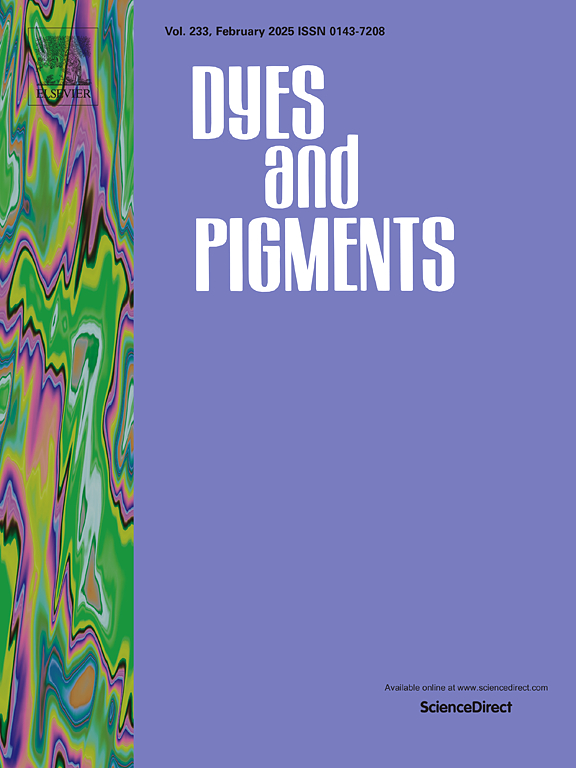漆酶催化丁香酸聚合环保棉染色:机理、优化及多功能性能
IF 4.1
3区 工程技术
Q2 CHEMISTRY, APPLIED
引用次数: 0
摘要
随着人们对环境可持续性的日益重视,环保染整工艺的发展已成为世界范围内的研究热点。本研究以棉织物为底物,壳聚糖为改性剂,利用漆酶催化丁香酸聚合,形成有色聚合物。这种方法创新性地将单体聚合、织物染色和功能性整理整合到一个单一的过程中。利用紫外可见光谱、傅里叶变换红外光谱和质谱分析了聚合产物的结构特征,并系统地阐明了聚合机理。以K/S值、色牢度、纤维表面形貌等指标评价织物的染色性能,并对不同染色方法进行比较,确定最佳反应条件。此外,还研究了染色织物的力学性能和功能性能。利用分子动力学模拟分析了壳聚糖与有色聚合物的亲和关系和相互作用模式。结果表明,在漆酶的催化作用下,丁香酸单体发生脱氢反应,形成苯氧键(Ph-O)和苯基键(Ph-Ph),合成了具有不同颜色的聚丁香酸(PSA)。值得注意的是,ph - ph连接的PSA主要通过CN键与壳聚糖表现出更强的亲和力。与两步染色工艺相比,一步染色工艺的性能更优,得到的织物颜色均匀,色深高(K/S = 11.57),色牢度好(4-5级),与未染色的棉织物相比,机械性能也有所提高。此外,染色织物表现出优异的抗氧化、抗紫外线和抗菌性能。本研究为绿色可持续染整技术的发展提供了理论基础和技术支持。本文章由计算机程序翻译,如有差异,请以英文原文为准。

Laccase-catalyzed polymerization of syringic acid for eco-friendly cotton dyeing: Mechanism, optimization, and multifunctional performance
With the growing emphasis on environmental sustainability, the development of eco-friendly dyeing and finishing processes has become a focal point of research worldwide. In this study, cotton fabric was selected as the substrate, chitosan was employed as a modifier, and laccase was utilized to catalyze the polymerization of syringic acid, leading to the formation of colored polymers. This approach innovatively integrated monomer polymerization, fabric dyeing, and functional finishing into a single process. The structural characteristics of the polymerized products were analyzed using UV–Visible spectroscopy, Fourier transform infrared spectroscopy, and mass spectrometry, and the polymerization mechanism was systematically elucidated. The dyeing performance of the fabrics was evaluated based on K/S values, color fastness, and fiber surface morphology, while different dyeing methods were compared and optimized reaction conditions were determined. Additionally, the mechanical and functional properties of the dyed fabrics were investigated. Molecular dynamics simulations were employed to analyze the affinity and interaction modes between chitosan and the colored polymers. The results revealed that under laccase catalysis, syringic acid monomers underwent dehydrogenation, forming phenoxy (Ph-O) and phenyl (Ph-Ph) linkages, leading to the synthesis of polysyringic acid (PSA) with distinct coloration. Notably, Ph-Ph-linked PSA exhibited a stronger affinity with chitosan, primarily via C![]() N bonding. Furthermore, the one-step dyeing process proved superior performance compared to the two-step process, yielding fabrics with uniform coloration, high color depth (K/S = 11.57), excellent color fastness (grade 4–5), and enhanced mechanical properties relative to undyed cotton fabrics. Moreover, the dyed fabrics demonstrated outstanding antioxidant, ultraviolet resistance, and antibacterial properties. This study provides a theoretical foundation and technical support for the advancement of green and sustainable dyeing and finishing technologies.
N bonding. Furthermore, the one-step dyeing process proved superior performance compared to the two-step process, yielding fabrics with uniform coloration, high color depth (K/S = 11.57), excellent color fastness (grade 4–5), and enhanced mechanical properties relative to undyed cotton fabrics. Moreover, the dyed fabrics demonstrated outstanding antioxidant, ultraviolet resistance, and antibacterial properties. This study provides a theoretical foundation and technical support for the advancement of green and sustainable dyeing and finishing technologies.
求助全文
通过发布文献求助,成功后即可免费获取论文全文。
去求助
来源期刊

Dyes and Pigments
工程技术-材料科学:纺织
CiteScore
8.20
自引率
13.30%
发文量
933
审稿时长
33 days
期刊介绍:
Dyes and Pigments covers the scientific and technical aspects of the chemistry and physics of dyes, pigments and their intermediates. Emphasis is placed on the properties of the colouring matters themselves rather than on their applications or the system in which they may be applied.
Thus the journal accepts research and review papers on the synthesis of dyes, pigments and intermediates, their physical or chemical properties, e.g. spectroscopic, surface, solution or solid state characteristics, the physical aspects of their preparation, e.g. precipitation, nucleation and growth, crystal formation, liquid crystalline characteristics, their photochemical, ecological or biological properties and the relationship between colour and chemical constitution. However, papers are considered which deal with the more fundamental aspects of colourant application and of the interactions of colourants with substrates or media.
The journal will interest a wide variety of workers in a range of disciplines whose work involves dyes, pigments and their intermediates, and provides a platform for investigators with common interests but diverse fields of activity such as cosmetics, reprographics, dye and pigment synthesis, medical research, polymers, etc.
 求助内容:
求助内容: 应助结果提醒方式:
应助结果提醒方式:


